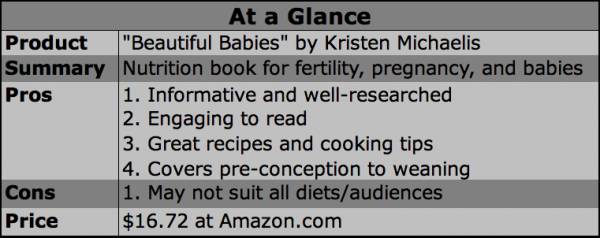
If you follow Kristen Michaelis’s blog, Food Renegade, you’ve probably been anticipating the release of her new book, Beautiful Babies. The book is a primer in traditional nutrition for fertility, pregnancy, nursing, and feeding babies. Far more than that, it is a thorough and honest – albeit unconventional – commentary on some of the downfalls of modern conventional nutrition.
 I was excited to read this book and wondered if Michaelis could really pull it off. A book about nutrition from pre-conception to weaning seemed like a very large task. And if you’re familiar with more lengthy books that advocate the work of Weston Price or paleo and primal diets, you know there’s a lot to say about these food issues. To cover all these topics in about 250 pages seemed ambitious, to say the least.
I was excited to read this book and wondered if Michaelis could really pull it off. A book about nutrition from pre-conception to weaning seemed like a very large task. And if you’re familiar with more lengthy books that advocate the work of Weston Price or paleo and primal diets, you know there’s a lot to say about these food issues. To cover all these topics in about 250 pages seemed ambitious, to say the least.
Michaelis has managed to draw out the most important research and present it in an engaging way. I learned a lot reading this book and also enjoyed it. Here are just a few of the topics addressed in Beautiful Babies:
- Foods to avoid and healthier choices
- Information about fats, grains, and sugars
- Benefits of raw and fermented foods and organ meats
- How to reduce morning sickness and other pregnancy ailments
- Important vitamins and minerals for pregnancy
- How to increase fertility with diet
- How to prepare traditional foods for yourself and baby
- Tips for breastfeeding and baby-led weaning
- Advice for eating real food on a budget
- Homemade healthy formulas
- Food additives to avoid
I was impressed at the author’s ability to present all this information in a thorough manner without watering down the research or resorting to simply recounting her own personal preference. I would highly recommend this book as an excellent starting point for anyone interested in ancestral nutrition during the reproductive period.
Beautiful Babies is both informative and practical. The first part of the book is packed with information and research. The second part, called “Recipes for Sacred Foods,” provides over fifty recipes for snacks, condiments, organ meats, bone broth, seafood, eggs, and drinks for reproductive and baby health. As with most ancestral food, the recipes are simple and revolve around high-quality, nutrient-dense ingredients.
 Some of the recipes might be intimidating to some readers, so here’s a warning: you will not find recipes for healthy rice cereal. Although there are lots of delicious recipes in this book that will appeal to most readers, you will also find recipes for liver, tongue taco meat, and fish roe salad. Once upon a time, this would have been a gross-out factor for me. I really owe my changed opinion to my husband, who has always been much more enthusiastic about trying out liver and onions and sweetbreads than I have. However, I have to admit that since our family has added some of these foods to our diet, we’ve noticed marked improvements in our health. Not to mention, they’re actually quite tasty when prepared properly.
Some of the recipes might be intimidating to some readers, so here’s a warning: you will not find recipes for healthy rice cereal. Although there are lots of delicious recipes in this book that will appeal to most readers, you will also find recipes for liver, tongue taco meat, and fish roe salad. Once upon a time, this would have been a gross-out factor for me. I really owe my changed opinion to my husband, who has always been much more enthusiastic about trying out liver and onions and sweetbreads than I have. However, I have to admit that since our family has added some of these foods to our diet, we’ve noticed marked improvements in our health. Not to mention, they’re actually quite tasty when prepared properly.
Although some of the diet recommendations in this book may not appeal to strict paleo followers or vegans, for the most part Beautiful Babies takes a balanced approach to eating. This is one thing I love about the Food Renegade blog. Michaelis has a way of seeking out the similarities between different “diet camps” and finding a common denominator. In our own family, we’ve experimented with following stricter versions of the paleo diet as well as Weston Price. In the end, what has worked best for us is a diet based primarily around raw and prepared fruits and vegetables, local grassfed animal products in limited amounts (limited more due to budget than desire!), occasional traditionally-prepared grains and legumes, and daily consumption of bone broth and fermented foods. This book is one of my favorite resources to keep that diet going.
Here are two critiques I could offer for this book. First, I feel some of the recommendations might not work for everyone. In my time volunteering with pregnant and new moms, a lot of the women I’ve worked with are obese, diabetic, and even fighting food addictions. Telling them to drink a quart of grassfed milk every day and get a good daily dose of coconut oil and butter might not be the best recommendation. If I did offer that advice, I would be sure to also mention a significant increase in physical activity.
This leads me to my second criticism. There is little mention of the need for regular physical activity here. It does less good to eat like our ancestors when our movement habits are trapped in cubicles or in front of a television. It would have been great to see a chapter or two on healthy movement and exercise during the reproductive years.
But really that’s just me playing devil’s advocate. This is a fabulous book and I highly recommend it to anyone who wants to learn more about ancestral eating for fertility, pregnancy, or raising little ones. Transitioning from modern eating habits to a nutrient-dense, ancestral diet is an ongoing process, and Beautiful Babies will guide you in that journey.
“Beautiful Babies” is available for $16.72 at Amazon.com.






